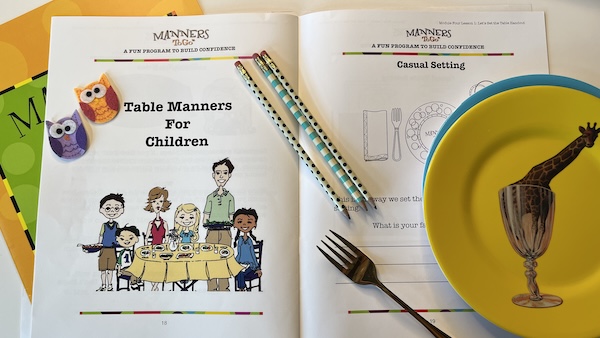
Supper or Dinner? Do you know the difference?
I grew up in the south and some days I would go directly to my grandmother’s after school.
She was such a good southern cook – chicken and dumplings, greens, fried chicken and the best biscuits ever!
I remember as a little girl, she would often refer to certain meals as “supper”.
Today’s article defines the difference between supper and dinner.
For those on the path to etiquette certification, you’ve probably heard the age-old question: is it supper or dinner? What may seem like a simple choice of words can actually reveal much about tradition, culture, and style. As a soon-to-be certified etiquette expert, you’ll want to know the difference—and how to teach it with charm and grace. So, let’s serve up the facts with a side of fun, shall we?
Supper vs. Dinner: What’s the Difference?
Before you begin crafting your manners lesson plans and activities, it’s important to know the subtle (and not-so-subtle) distinctions between supper and dinner. Here’s a chic, bite-sized breakdown:
- Dinner is typically considered the main meal of the day, often served in the evening but not always. The word “dinner” comes from the French word “dîner,” meaning to dine, and it originally referred to the largest meal—regardless of the time of day.
- Supper, on the other hand, is a lighter evening meal. It’s more casual, often served later in the evening or even after an early dinner. Supper has a cozy, homey feel—it’s less about grandeur and more about comfort.
In essence, if you’re sitting down to a grand feast with multiple courses and maybe even a bit of formal attire, it’s dinner. If you’re enjoying a light meal with a more relaxed vibe, it’s supper.
Teaching the Difference: Stylish, Sophisticated, and Fun
For those creating etiquette certification lesson plans, knowing how to teach this distinction is key. Here’s how you can weave this concept into your curriculum with flair:
- Dinner Party Perfection: Plan a mock dinner party for your participants. Create an activity where they plan both a formal dinner and a cozy supper. Have them explore not only the menu but also the differences in ambiance, attire, and table setting. This is an excellent way to teach table manners while offering them a creative, hands-on experience.
- Role-Playing: In your next etiquette course, why not have your students play the roles of host and guest for both a supper and a dinner scenario? This interactive approach will help them understand the social nuances and expectations that come with each occasion.
Supper or Dinner? Why It Matters
As etiquette experts, your goal is to equip clients with the confidence to gracefully handle any dining situation. Whether they’re hosting a formal dinner or inviting friends over for a casual supper, knowing the difference will help them make informed decisions—especially when it comes to teaching table manners.
While dinner is often associated with formal dining etiquette (cue the forks, knives, and maybe even a seating chart), supper is more relaxed. It’s a time for informal conversation, cozy meals, and simple pleasures. Teaching your students when each is appropriate—and how to navigate both settings—will be a stylish skill they’ll always appreciate.
Bringing It to the Table: How to Teach Kids About Supper and Dinner
If your manners lesson plans involve working with children, teaching the difference between supper and dinner can be a playful, engaging activity.
- “What’s for Dinner?” Game: In this fun activity, create a scenario where the kids plan a meal. Is it a formal dinner with multiple courses, or a cozy supper with comfort food? You can use toys or props to help illustrate the different settings, teaching them about table manners in a way that’s easy to understand.
- Table Setting Fun: Show children how the table setting might change for supper vs. dinner. A dinner setting might include extra utensils and a more formal arrangement, while a supper table could be simpler and more relaxed. Teaching them the difference allows for an early understanding of manners at the table that can grow with them.
Conclusion: Serving Up Etiquette Expertise with Supper and Dinner
In the world of etiquette, even the smallest details matter—and knowing the difference between supper and dinner is one of those stylish distinctions every certified expert should master. Whether you’re teaching adults to host an elegant dinner party or showing children how to set a cozy supper table, it’s all about blending sophistication with a touch of fun.
Ready to teach your students to dine with grace, no matter the meal? It’s time to put the “chic” in your certification!
Related Article: Being Fancy for Etiquette Experts
Here is a FREE Guide to Help YOU Start a Business Teaching Manners to Children
CLICK THE IMAGE TO GET THE DOWNLOAD RIGHT NOW
Here Are Your Next Steps

Get to Know Manners To Go™
Most likely, you will want to get to know us. Feel free to call or email us. Click on the links below. We are happy to discuss the details with you.

Decide on the best training option for you
We offer two trainings to become certified to teach manners to children:
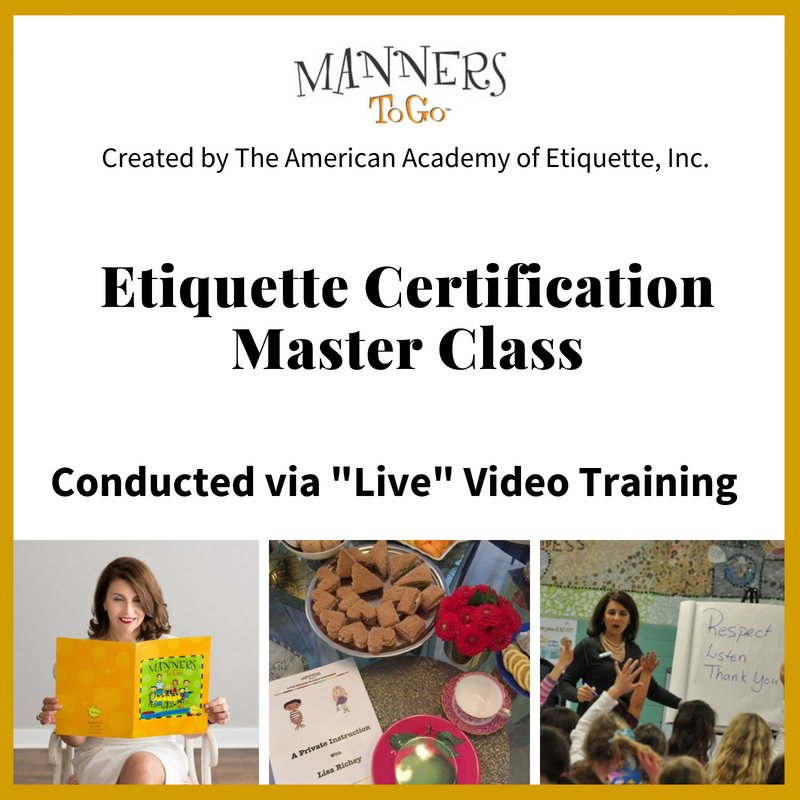
Option #1:
“Live” Video Training
If you are looking to start immediately and save money on travel and time, then this is your best option.You choose the dates of our trainings. Most choose to have their sessions once a week, others twice. This is a “live” and private training. It is NOT self-guided.
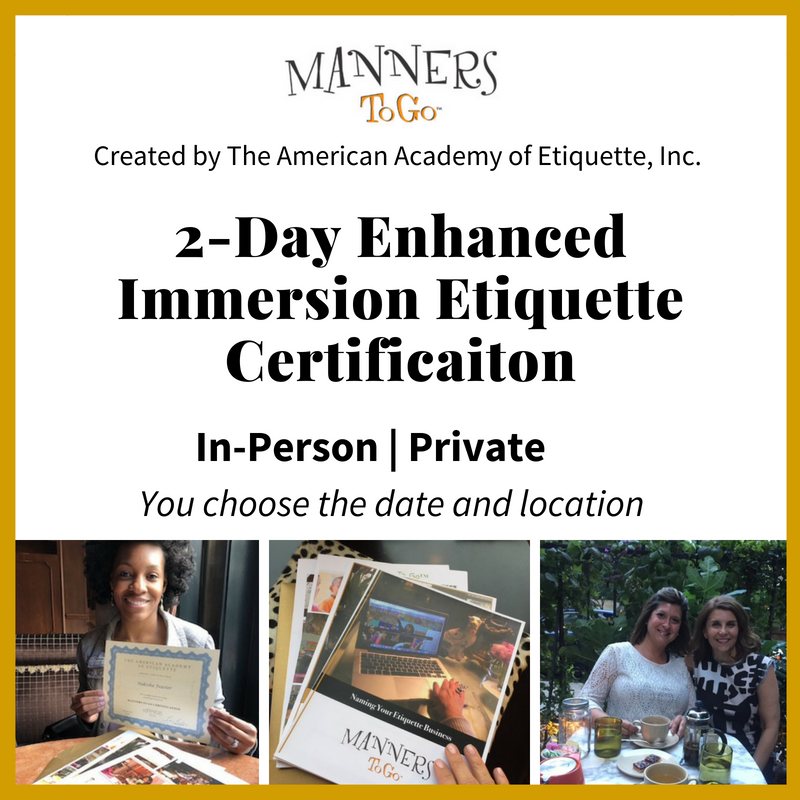
Option #2:
Two-Day In-Person
PRIVATE Training. That’s right, we meet in person, the two of us and our focus is completely on your business. Click the image above or follow the button below to learn more and to see a list of cities available for your training.

Receive the curriculum and book your training dates
Upon payment, you receive the curriculum. Next, we will send an email asking you to schedule your first training date.

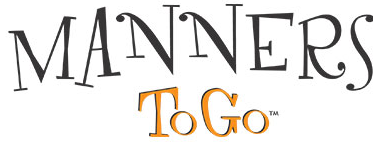
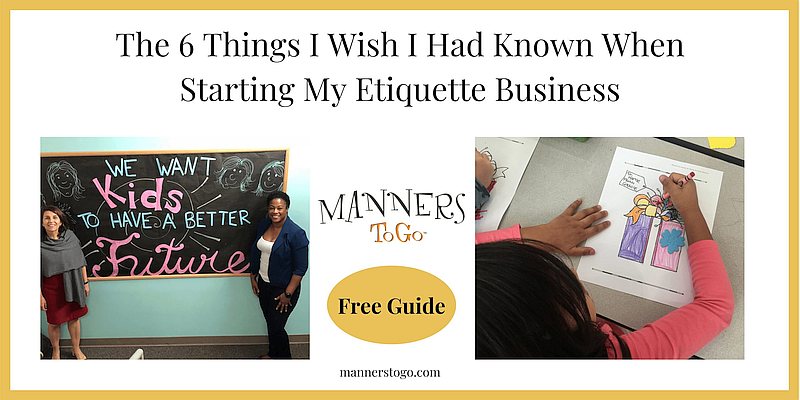
 Lisa Richey provides etiquette programs to businesses, schools, and individuals.
Lisa Richey provides etiquette programs to businesses, schools, and individuals.



